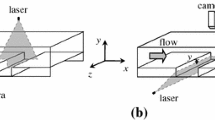Abstract
The variational principle in terms of stream function Ψ for free surface gravity flow is discussed by the formulation of first-order variation in a variable domain. Because of different transversal conditions adopted, there are four forms of variational principle in terms of Ψ.
An air-filled cavity flow with given discharge and total energy is then analysed by finite element method. At the end of the cavity, the free stream line is tangent to a short fictitious plate of given length, which joins the fixed boundary at an angle to be determined. The condition that the free stream line should be tangent to the fixed boundary at the point of separation makes the solution unique.
Finally curves giving the cavity length as a function of the Froude number, cavity pressure and channel bottom slope are presented.
Similar content being viewed by others
References
Wu. Th. Y-t., Cavity and wake flowsAnnual Review of Fluid Mechanics,4 (1972).
Ikegawa, M., K. Washizu, Finite element method applied to analysis of flow over a spillway crest,Inter. J. of Num. Mech. in Eng.,6 (1973).
Hsu, H. C., Finite Element Computation of the Pressure Distribution Along the Right Bank Spillway of Wu Jiang Du Water Power Station, Internal Report, Institute of Water Conservancy and Hydroelectric Power Research (1976).
Hsu, H. C., A Method for the solution of Free Surface Gravity Flow by Finite Elements,J. of Hydraulic Engineering, 1 (1980).
Varoglu, E., W. D. Liam. Finn, Variable domain finite element analysis of free surface gravity flow,Computers and Fluids, 6 (1978).
Betts, P. L., A variational principle in terms of stream function for free surface and its application to the finite element method,Computers and Fluids, 7 (1979).
Courant, R., and D. Hilbert,Methods in Mathematical Physics, Vol. I, Interscience, New York (1953).
Xu Xie-qing (Hsu, Hsich-ching), Zhou Sheng, Pressure Distribution, and Incipient Cavitation Number for Isolated Surface Irregularity Formed with a Circular Are, Internal Report (1964), Collected Research papers, Vol. VII (1982), Institute of Water Conservancy and Hydroelectric Power Research.
Knapp, R. T., J. W. Daily, F. G. Hammitt,Cavitaioion (1970).
Author information
Authors and Affiliations
Additional information
Communicated by Chien Wei-zang.
Most of the work presented in this paper was done by the first writer under the direction of the second writer as a thesis project for master's degree at the department of Hydraulic Engineering of Tsinghua University.
Rights and permissions
About this article
Cite this article
Bin-yao, L., Xie-qing, X. Analysis of two-dimensional cavity flow by finite elements. Appl Math Mech 6, 483–493 (1985). https://doi.org/10.1007/BF01895385
Received:
Issue Date:
DOI: https://doi.org/10.1007/BF01895385




